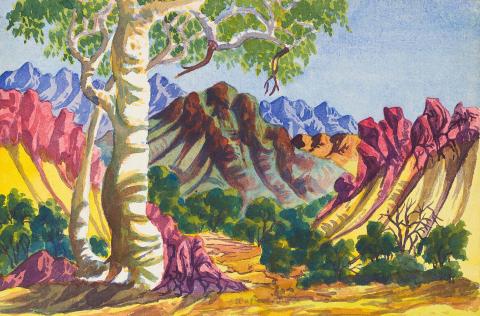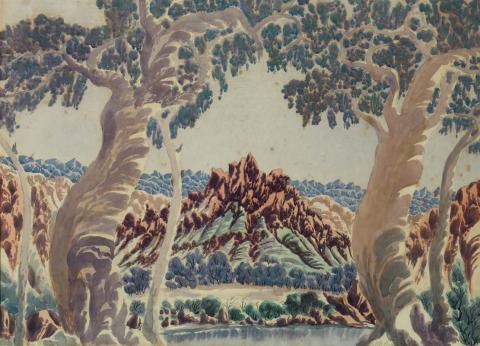ESSAY: Otto Pareroultja
Otto, along with his brothers Edwin and Reuben, adopted the name of his father, Pareroultja, when he commenced painting and needed a surname to ‘fit-in’ with their European Australian audience. This name is associated with their family dreaming site, a part of the native cat narrative, near Mount Sonder.
Encouraged by his younger brother Edwin’s success with an idiosyncratic approach, Otto began painting in a style that immediately drew a primitive, totemic or mythological label within an otherwise staid genre. His colourful, striated trees and monoliths drew comparisons with decorated people and accoutrement in Arrernte ceremony.
In his earlier works, trees seem to move through the landscape, taking the shape of Arrernte ancestor spirits, while masses move and morph and forms and faces appear in the cliffs and rocks. Later, Pareroultja’s oeuvre focused on a repeated rock mass, often framed by two trees painted as if ceremonially decorated or scarred. Within the landscape a path became visible, leading the viewer through country. This is the ‘dreaming track’, the path that associated ancestor spirits travelled in their creative journey.
Each of Pareroultja’s later paintings became a ceremony. Each holds all of the key elements of ceremony — decorated participants, the place, the story or song for the place and the dreaming tracks through country. Indeed, some even showed the ancestors themselves. Each of his works strengthened the ties between himself and his country through continually ‘performing’ his paintings.
Sadly, the artist never talked about the significance of symbolism in his works, as he was never asked, but we are able to glimpse it through his overt imagery in his works which occupy a plane between physical reality and Arrernte mythology.
Feature image: Otto Pareroultja / Arrernte people / Australia NT 1914–73 / (Landscape) c.1950s / Purchased 2003. Queensland Art Gallery Foundation Grant / © Otto Pareroultja Estate
Connected objects

(Landscape) c.1950s
- PAREROULTJA, Otto - Creator

(Landscape) c.1950s
- PAREROULTJA, Otto - Creator
Related artists
PAREROULTJA, Otto
1914
- 1973
Full profile
for PAREROULTJA, Otto
Metadata, copyright and sharing information
About this story
- Subject

